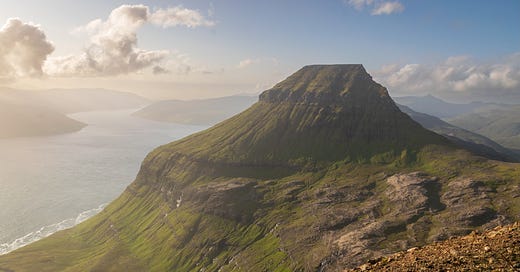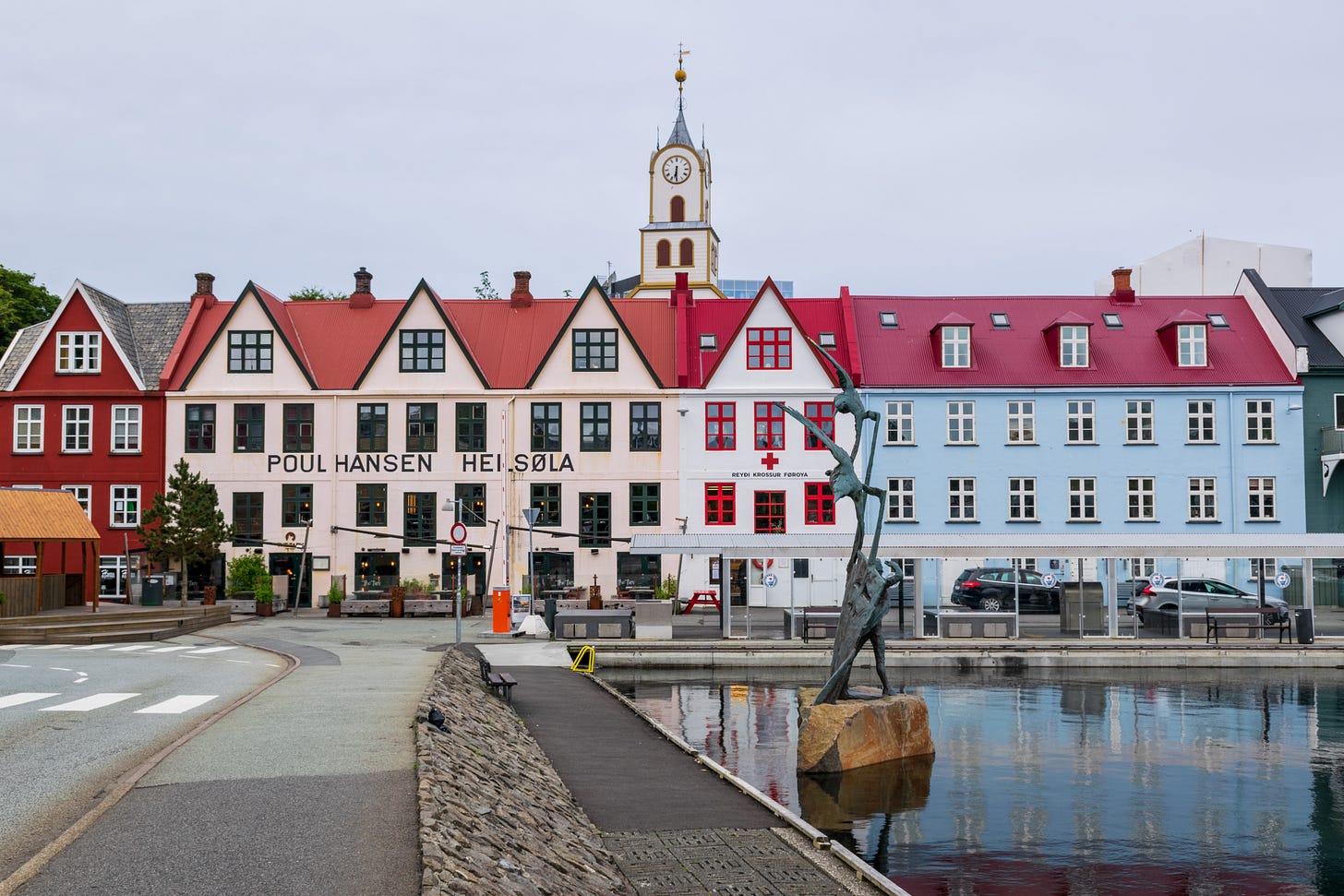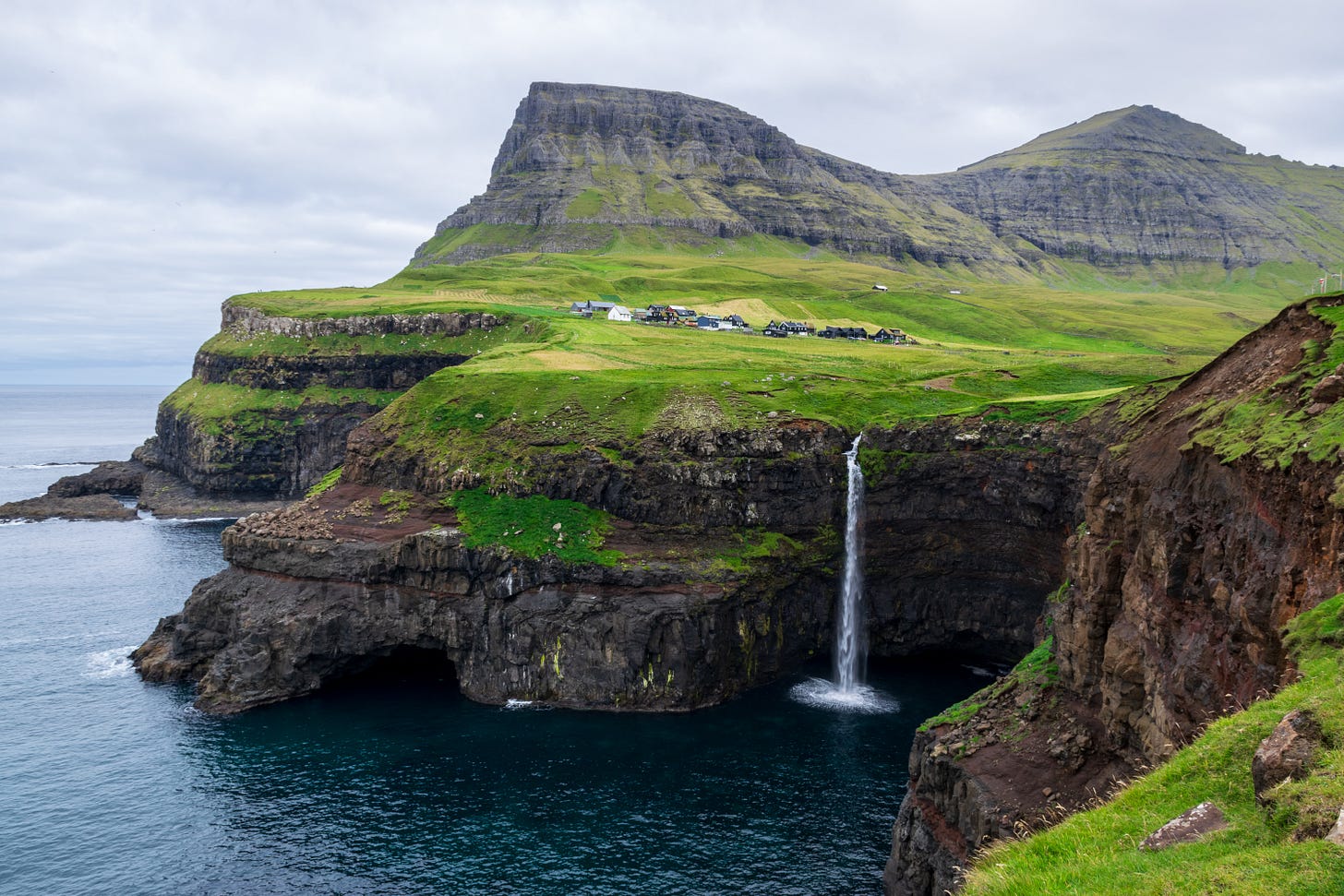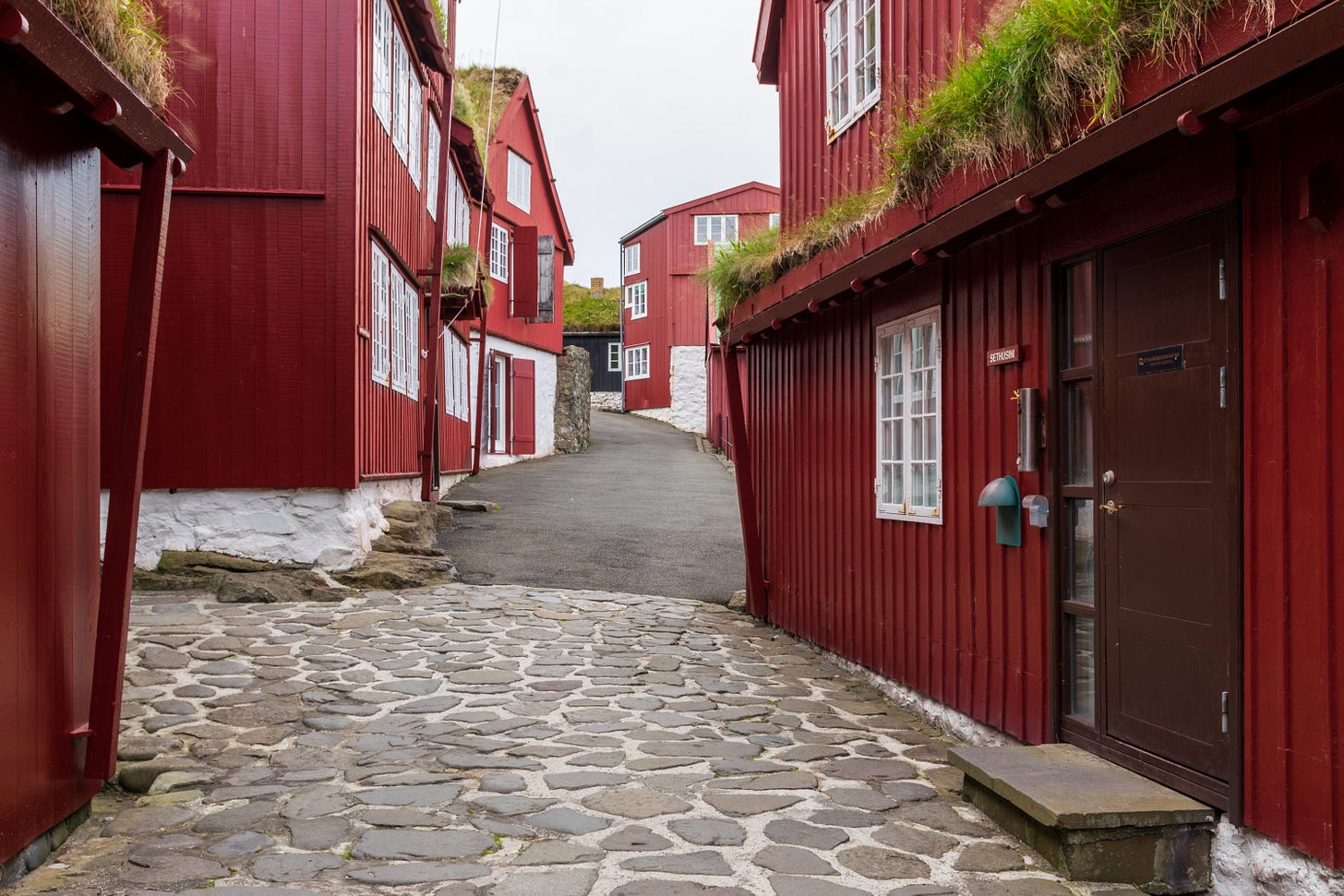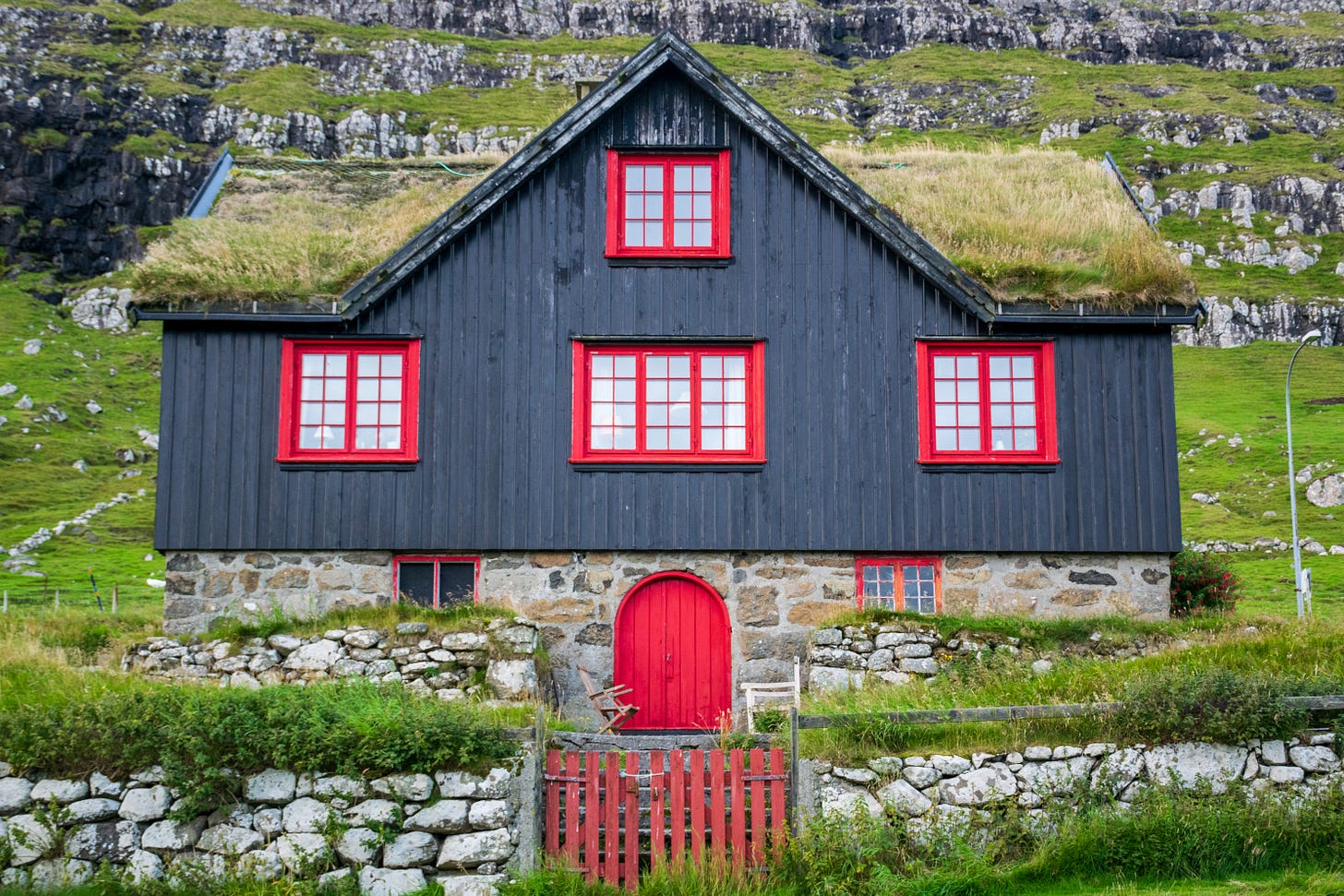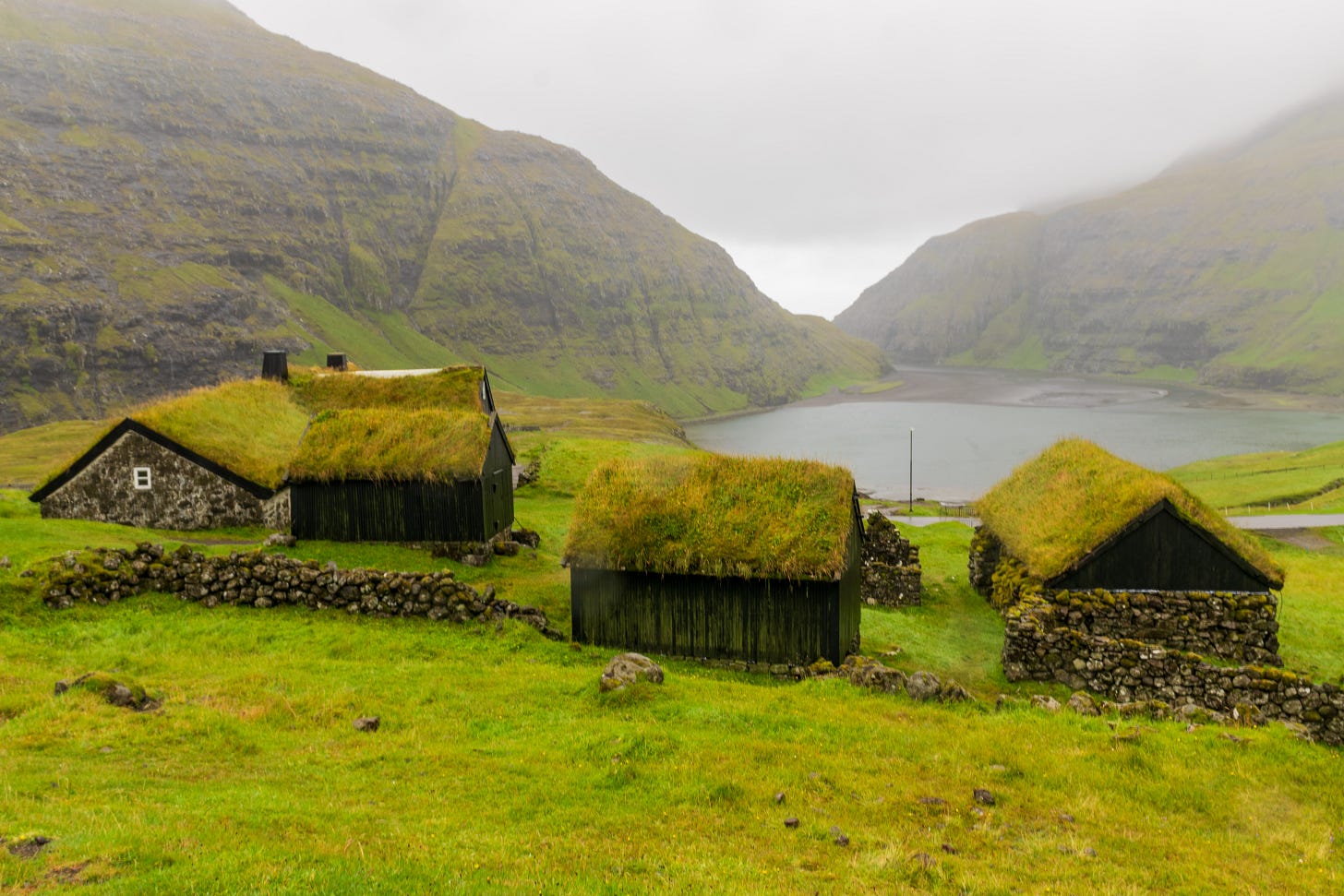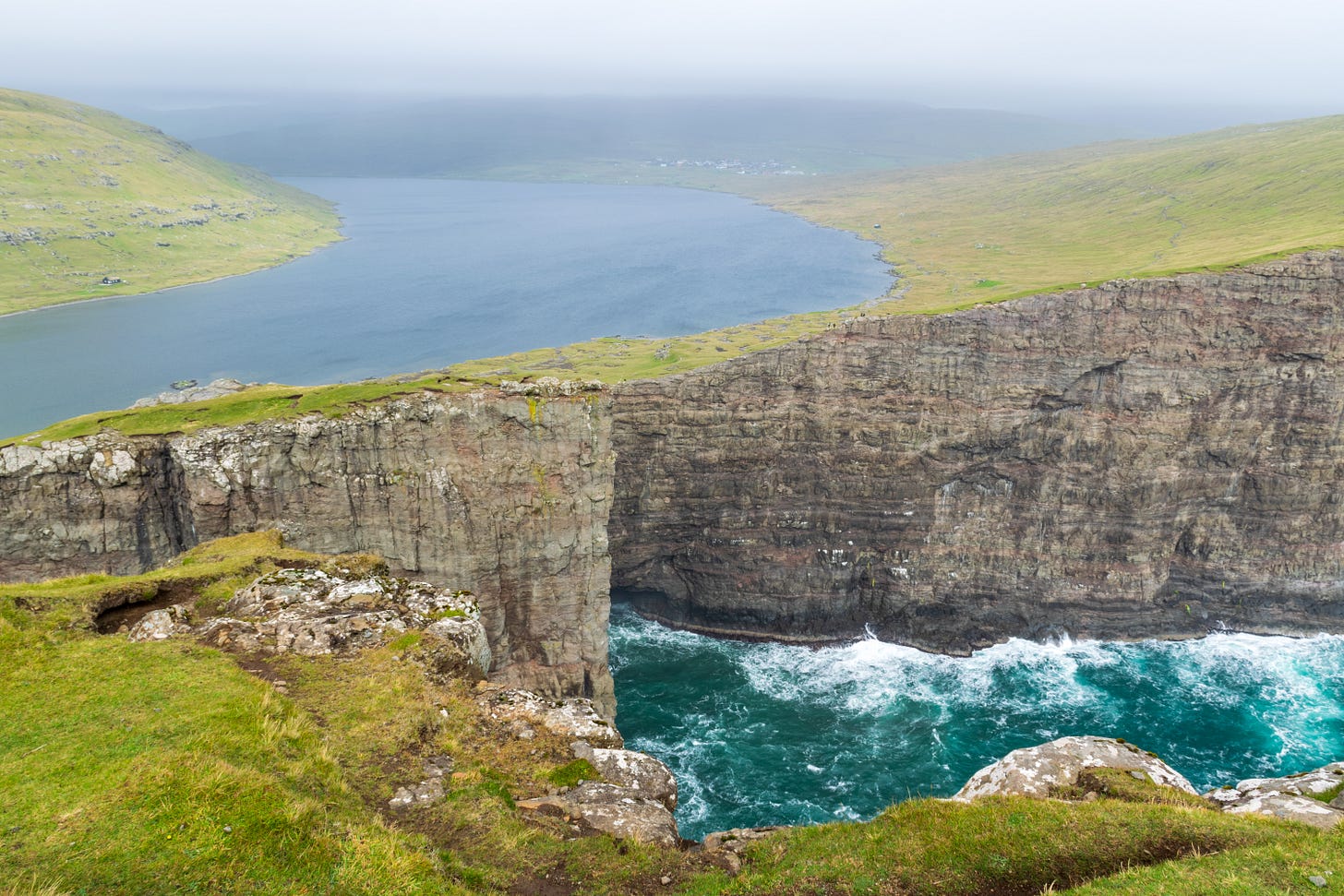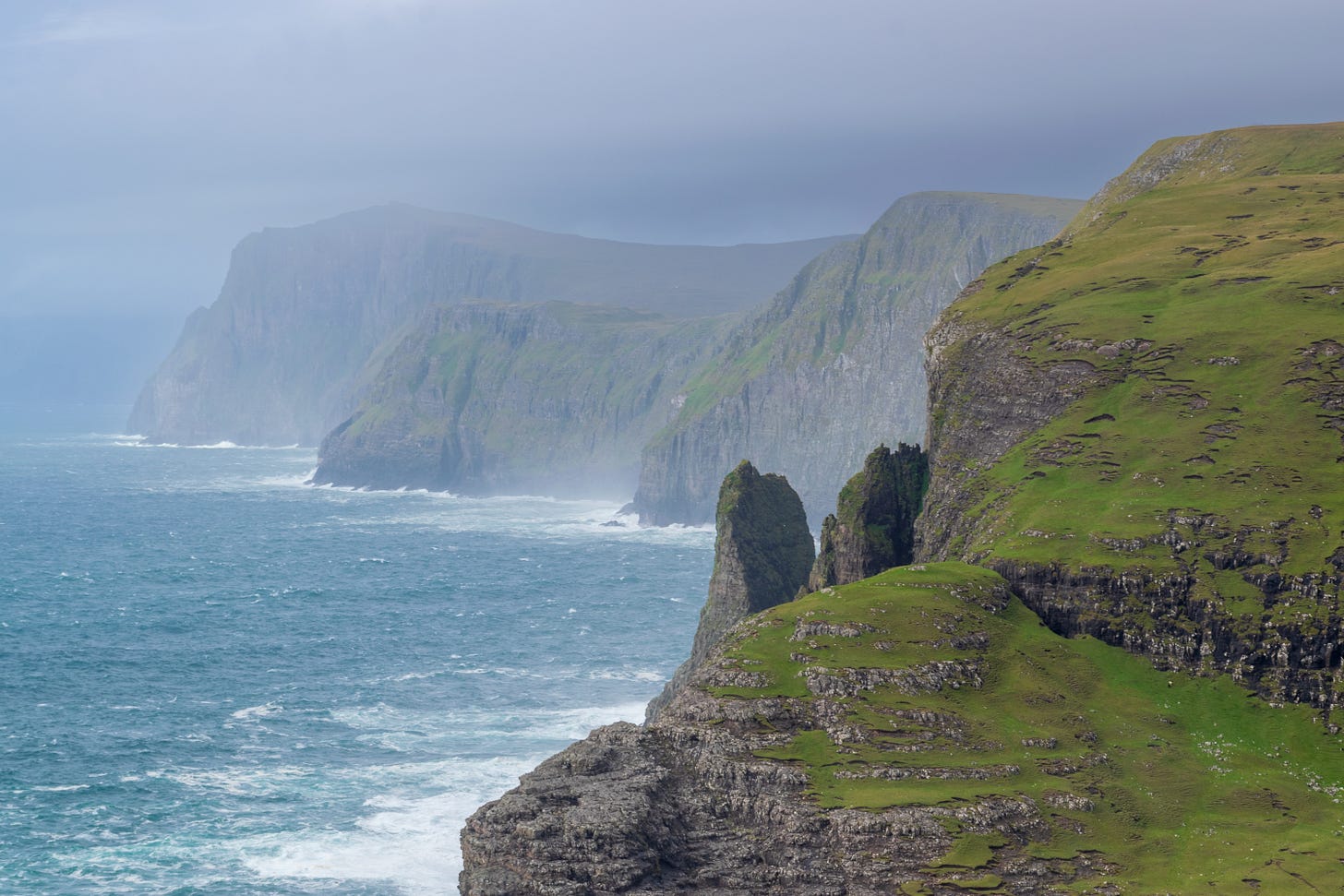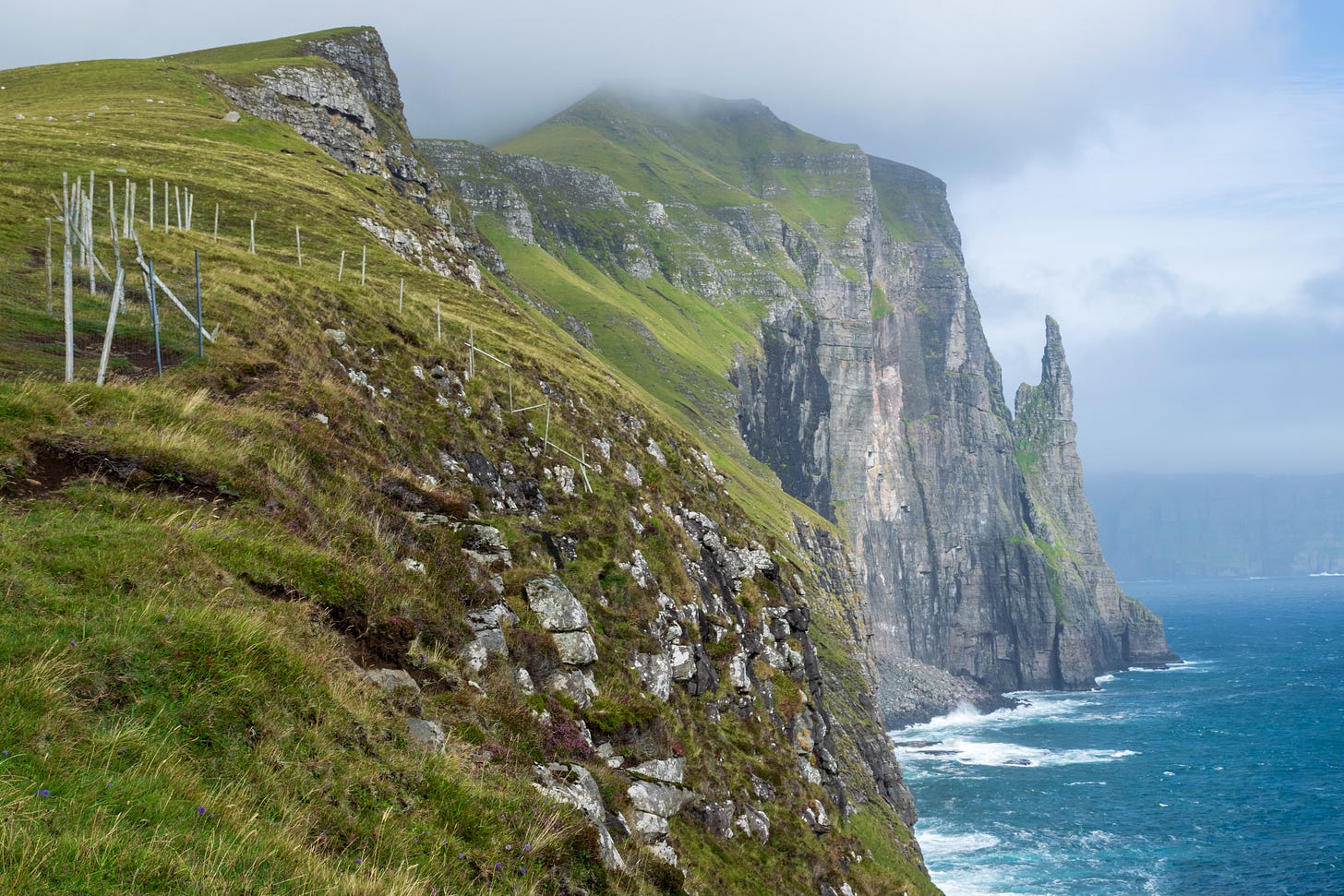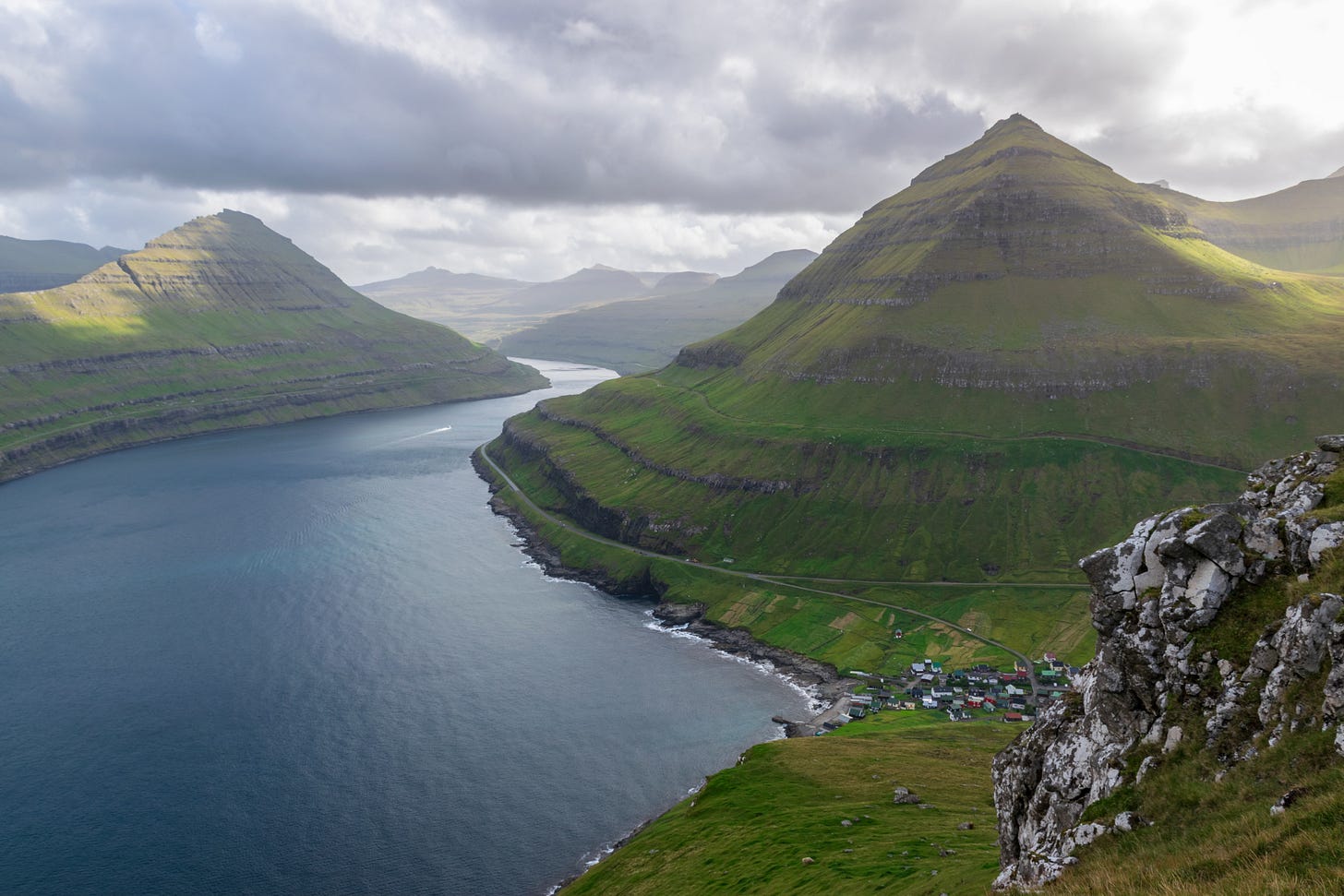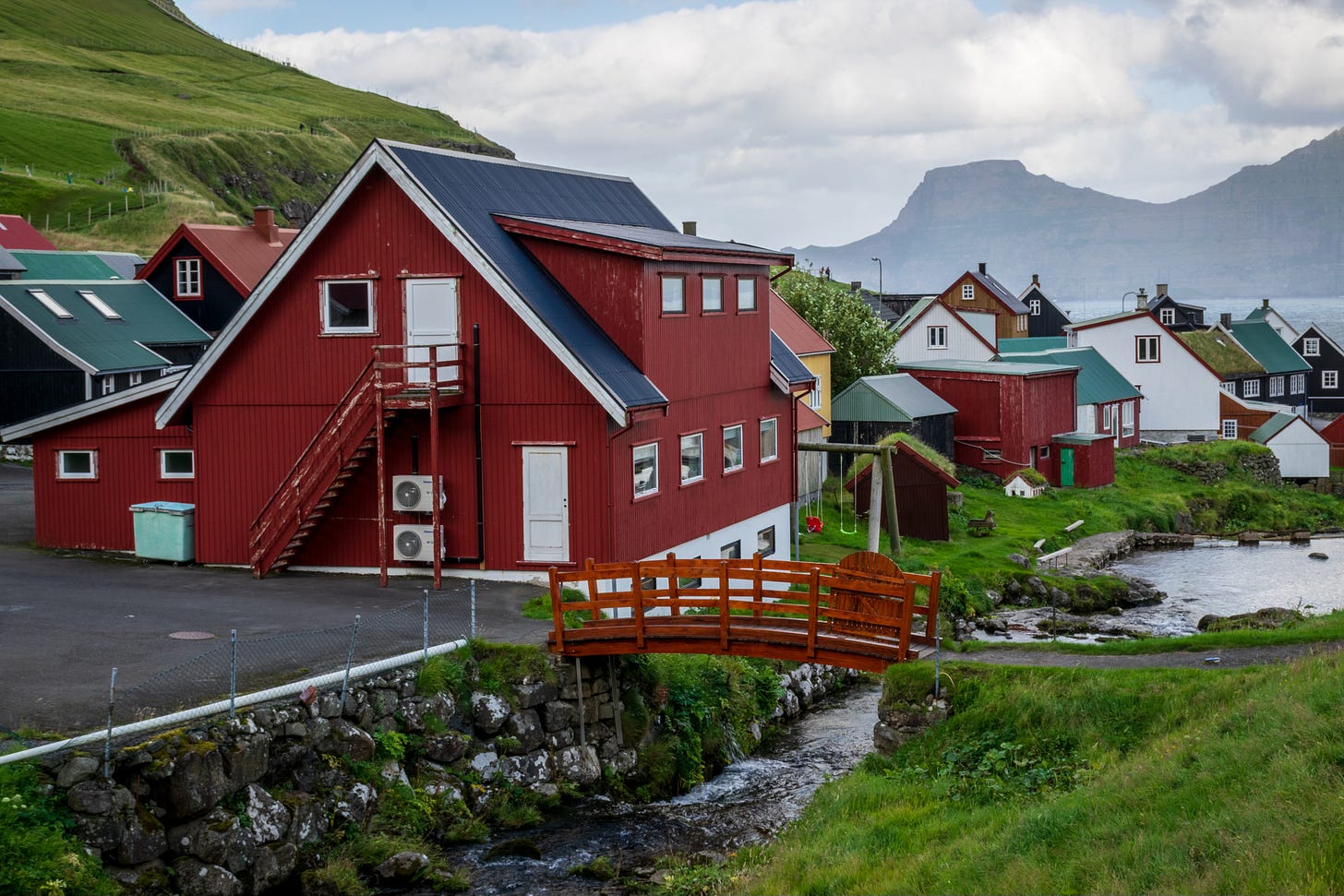The Faroe Islands have long been on my bucket list. Gripped by images of sheer cliffs and enchanting waterfalls, I felt an undeniable pull to explore these elusive islands nestled halfway between Iceland and Norway. When the first-ever nonstop flights from the United States to the Faroe Islands were announced, I knew I had to visit. And so, after a six-hour flight, I arrived in the Faroe Islands, a group of eighteen windswept islands where sheep outnumber humans by about 30,000, a place where there are five traffic lights, one prison big enough for only 12 inmates, two fast-food restaurants, and a place where the tallest ‘skyscraper’ is a 41 meter church.
The plane was barely 1/3 full, which is not surprising considering the blank looks I got when I told people I was visiting the Faroe Islands. I picked up a rental car from Vagar Airport, built by the British during their occupation of the islands in World War Two. The night was chilly and smelled of the ocean. It was a smooth drive through winding roads and tunnels before I reached Torshavn, the small capital where I would be spending the next six nights.
The first thing you would probably see if you googled the Faroe Islands would be the Múlafossur Waterfall, and that was my first destination for the trip. The drive was filled with stunning scenery and many, many sheep. The warnings about being wary of sheep were no exaggeration - they were sometimes very unpredictable and would just run down from the hills to blindly cross the road. Horses and Highland cows also occasionally dotted the sides of the road. Until recently, it was impossible to drive to the village of Gásadalur, known as Goose Valley where the waterfall is located. Even the postman had to hike to deliver mail on foot here - that old trail is now a popular hiking trail known as the 'Postman's Trail.' The vantage point for the waterfall was just a 300-meter walk and offered spectacular views of the cascading waterfall with the village and mountain in the background.
That afternoon, I took a walk to the center of Tórshavn to explore some of its sights. Its little harbor was cozy, with many boats and a line of colorful houses, along with a cathedral clock tower. From there, I walked to the remnants of an old fort, a relic from five hundred years ago when it was used to defend against pirates. This site now features a red and white lighthouse and rusting World War Two cannons. From its grass-covered ramparts, I could see a massive ferry (easily bigger than any building on the islands), probably taking passengers to Denmark or Iceland. After visiting the fort, I looped around to explore Tinganes - the historical district, which is one of the oldest parliamentary meeting places in the world. Here, alleyways meandered up and down past red-painted wooden buildings with sod roofs, showcasing the traditional Faroese style.
The next day, I took a ferry to Kalsoy - an island only accessible by boat. A bus dropped me off in the village of Trollanes, the furthest town on this sparsely inhabited island, to hike the trail to the famous Kallur Lighthouse. The hike started slowly, passing through a sheep gate and following a steep, narrow trail that hugged the edge of a hill. As the hike progressed, it opened up, crossing small streams and a very muddy countryside. Along the way, I encountered old stone sheep shelters, while the vast ocean loomed behind me. After some time, I spotted the lighthouse in the distance. Up to this point, the hike was not too challenging, but reaching the final viewpoint proved perilous. The trail descended before rising again, with drops of several hundred feet on both sides down to the ocean. It was also extremely slippery from the mud, and one misstep could mean disaster. Frozen in place, my feet locked as I grappled with the uncertainty of where to take the next step. Eventually, with cautious baby steps and a bit of spider-crawling, I reached the end and was rewarded with the view that had drawn me to this remote nation.
An incredible jagged peak provided a massive backdrop to the comparatively tiny lighthouse. Clouds clung to the top of the mountain as seabirds soared on the edges of the cliff. Up ahead, while returning past the lighthouse, was the tomb of James Bond as - spoiler alert - he died here in the last Bond film, "No Time to Die." As a huge 007 fan, it was special to see his tomb, where his gravestone read, "The proper function of man is to live, not to exist." - profoundly underscoring the adventurous spirit that I use to fuel such journeys.
A local sailor picked me and other travelers who had missed the sparsely scheduled ferry in his massive wooden sailboat called the "Dragin," which was adorned with a dragon's head. In the evening, I had just enough energy to visit the village of Kirkjubøur, the Faroe Islands' most important historical location with sites like the ruins of Magnus Cathedral (the largest medieval building in the Faroe Islands), St. Olav's Church (the oldest active church in the Faroes dating from the 12th century), and Kirkjubøargarður (the oldest still-inhabited wooden house in the world!).
The following day brought biting rain and a chilling wind. There's a saying about the Faroe Islands that goes something like, 'If you don't like the weather, wait five minutes!' to capture the rapidly changing conditions. Despite waiting, the weather did not improve. Not eager to embark on a challenging hike in bad weather, I opted to visit the secluded village of Saksun. I timed the visit around low tide to walk along the sandy shores of the lagoon at the foot of the village. The wind was incredibly powerful, blowing black sand against my face as I walked to the beachfront. The return walk was slightly easier with the wind at my back, allowing me to enjoy the views of the steep mountains and numerous waterfalls surrounding the lagoon. After the hike, I briefly explored the town, featuring a 19th-century white church and small turf houses, home to just eleven people.
I was scheduled to take a boat trip to the arch of Drangarnir - a rock formation rising 230 feet out of the Atlantic Ocean. A group of us settled into our seats on a small rib boat, which departed from a boat harbor near the sea arch. As soon as the boat left the harbor, the ocean became extremely turbulent, and we were violently slamming onto the ocean so hard that I was sure the boat would break. The waves grew rougher as we approached our destination, and I mentally noted any landmarks where I could seek rescue in case of a sinking, as if I would survive in the open North Atlantic Ocean. We were supposed to land on some rocks near the sea arch, but the high tide made the water exceptionally unstable, rendering a landing impossible. The captain eventually decided to turn around and return to the harbor, informing us that he would attempt a landing again in about an hour. I chose not to tempt fate again and canceled the tour.
Instead, I decided to do one of the most popular hikes in the Faroe Islands - the hike to Traelnipa to see the lake above the ocean. It was somewhat expensive to hike this trail (nearly $30 USD), and, in fact, many of the viewpoints and hiking trails in the Faroe Islands require steep fees to maintain the paths, compensate the farmers who own the land, and manage overtourism. Regardless, I wasn't going to come this far and not pay to hike these bucket-list trails. The walk was easy despite the rain and the wind, and even these eventually subsided.
The trail followed Lake Leitisvatn - the largest in the country, and after a steep ascent, I reached the summit of Traelnipa, a rock wall jutting out 142 meters from the sea. This place translates to 'slave cliff' because during the Viking Age, slaves were pushed off the edge of the cliff. From the top, I could see the famous optical illusion - the lake appearing as if it were hundreds of feet above the ocean. On the opposite side, the ocean shimmered in the sunlight that had finally emerged, and in the distance were a series of massive cliffs. For several minutes, I simply watched the massive waves froth against the rocks - nature was truly a spectacle here.
Before heading back to Tórshavn to call it a day, I mustered just enough energy for one more modest hike (more of an inclined walk) to witness Trøllkonufingur, or the 'Witch’s Finger.' The northern countries, spanning from Norway to Iceland, and especially the Faroe Islands, are richly woven with myths and legends - tales of trolls, witches, and mermaids. These narratives add an extra layer of mystique to already epic landscapes. The trail meandered alongside majestic horses grazing in the grass, and sheep that seemed thoroughly alarmed at my intrusion. Amidst the rugged cliffside were nestled houses, perhaps belonging to sheep farmers. What kind of life must it be to reside on these remote fringes of society? This thought often strikes me when journeying to the farthest corners of our world, whether it be the Faroes, Patagonia, or the deserts of the Middle East.
The aptly named Witch’s Finger isn't just a remarkable natural formation; its story holds significant weight in local lore. Legend has it that Trøllkonufingur is the finger of a formidable witch who ventured to the Faroe Islands with the intent to hurl them northwards to Iceland. The tale recounts her unsuccessful mission, as she found herself at the sea, turning into stone under the sun's potent rays. According to the legend, she toppled backward into the ocean, leaving only her finger protruding from the water.
I continued exploring Tórshavn as the next day started slowly. This small capital was undeniably charming. I walked into the local bookstore, enjoyed sandwiches and coffee at a cozy cafe, and reveled in the hygge ambiance that permeated the city. After a relaxed morning, I drove about an hour to Eysturoy, the second-largest island in the Faroes. The road in Eysturoy hugged the coast before ascending dramatic switchbacks. While driving, a profound sense of awe filled me, and I instantly knew this was my favorite island. It was only later that I discovered Eysturoy is the most mountainous of the islands. I suppose I intuitively find a deep sense of joy in being surrounded by mountains.
I parked and started a short hike up the mountainside to reach the lower part of a ridge called Hvíthamar. The trail was extremely muddy and somewhat followed a cattle fence for about 20 minutes before arriving at the viewpoint. The hikes in the Faroes offer a great difficulty-to-view ratio. From there, a commanding panorama unfolded, showcasing the fjord and the encircling mountains. Glancing back towards the starting point, the zigzagging road I had taken to reach this vantage point was visible.
Venturing deeper into Eysturoy, I reached Gjógv - a tiny postcard village nestled on the northeastern tip of the island. I walked along a road that ran parallel to a small river cutting through the town, witnessing a scene seemingly untouched by time. The houses were in classic Scandinavian style, and in their bright green yards, I saw toy horses and swing sets for children and turf houses for the dogs. Dried fish hung outside many homes, offering a glimpse into the traditional way of life. On the fringes of the town, tracks led into the hills and mountains, occasionally revealing distant hikers. My walk eventually led to the town's natural harbor, from which it takes its name. Descending the steps to sea level, I marveled at how the gorge must have served as a refuge for fishing boats amidst the turbulent ocean storms. I will not soon forget this town on the edge of the world.
Some time later, I found myself navigating an impossibly steep mountain road, as if ascending into the heavens themselves. The twists and turns of this challenging path seemed a deliberate test of determination, almost an obstacle strategically placed to discourage visitors. Yet, echoing the wisdom of Mr. Bond, 'The proper function of man is to live, not to exist,' I pressed on. The ultimate reward awaited behind the final bend, with the sun defiantly piercing through stubborn clouds, casting a golden glow upon these remote islands at the world’s edge. My journey was more than just going through the motions of life; it was an embrace of challenges, a pursuit of adventure, and a quest for meaning and joy. Here, amidst these rugged landscapes, I discovered a profound sense of purpose and fulfillment. Here, I felt truly alive.


